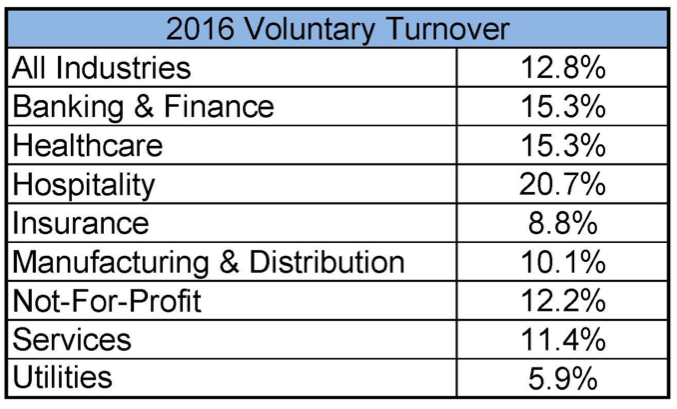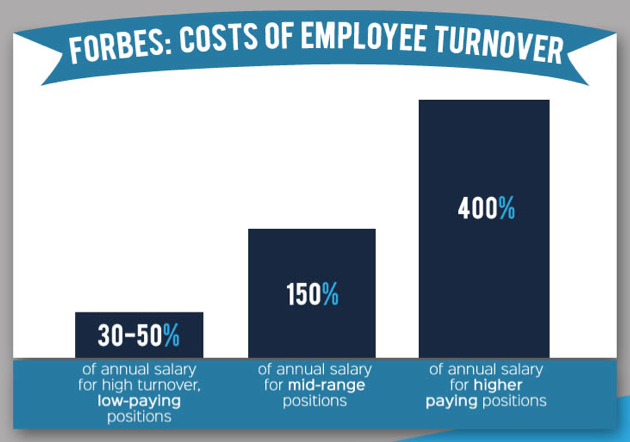Roughly half of the small to medium size businesses (SMBs) HR Resolved comes in contact with have previously found themselves in the seemingly relentless cycle of employee turnover and backfill. Many of these business owners accept 30+% annual voluntary employee turnover as “normal” and continue on the cycle year-over-year with no focus on understanding “why” or the resultant actions to fix the employee retention problem.
Note: Voluntary employee turnover occurs when an employee voluntarily chooses to resign from the organization.
Some SMB owners may recognize their organization is nearly 3x the national average for voluntary employee turnover. Yet the size of an employee turnover “problem” sometimes called poor employee retention, and the broad unfavorable impacts on the business still often go without real perspective.
Generally, targets for voluntary employee turnover are set near 10%, and no matter if voluntary employee turnover is “average” or “huge” — Employee turnover hits you right in the wallet, in a much bigger way then you may realize!

CompData’s 2016 edition of their annual BenchmarkPro Survey, featuring data submitted by more than 30,000 organizations
Employee turnover hits you right in the wallet, in a much bigger way then you may realize!
According to the US Bureau of Labor Statistics, turnover will cost an organization 33% of an employee’s total compensation (including wages and benefits)
∴ an employee paid ($55,000/year) x (1.25% overhead) = $68,750 total comp. – the costs of turnover is $22,688 / employee
The Society for Human Resource Management advocates turnover will cost an organization the equivalent of six to nine months of an employee’s salary
∴ an employee paid ($55,000/year) – the costs of turnover is between $27,500 – $41,250 / employee

Source – Forbes.com
Forbes, dives even deeper to understand the cost of employee turnover in organizations with more advanced, or complex, professional roles and advocates that speciality knowledge workers and experienced leader turnover drive the cost of employee turnover closer to 150% or more of an employee’s salary. So, a speciality knowledge worker or an outstanding leader paid $55,000/year will burden your organization with a cost to replace of greater than $82,500.
Weather we put our trust in the government, or a private entity, to study the financial impact of employee turnover it’s quick to see replacing each departed employee your company had been paying $55,000/year will cost the business between $22,688 – $41,250. Similarly, to replace each $15/hour employee the organization will be saddled with a $12,000 – $23,400 bill.
Are you realizing your organization is saddled by higher than desired employee turnover? HR Resolved would like to hear from you!
Voluntary Employee Turnover Working Example
Your 40-person organization saw a 16% voluntary employee turnover (many see nearly double) last year, you lost 6 people. If those 6 employees on average collected a salary of $55,000/year; approximately $195,000 went toward replacing the departed employees, as opposed to in your wallet, just last year alone!
A 6% decrease in voluntary employee turnover would put (on average) $65,000/year back in your wallet each year. While also circumventing all the other shortcomings (morale, performance, alignment, etc.) left behind with the organization as byproducts of voluntary employee turnover.
What are the Common (easily studied) Costs Drivers of Voluntary Employee Turnover?
Underproduction Pre-exit – The unfavorable impact to the business of a non-committed employee whose “head is not in the game” while they are dissatisfied and exploring other opportunities (pour work product, delays, absenteeism, detract from team, errors, etc.).
Vacancy – Loss of productivity and the costs of work covered by other employees (including overtime), temporary employees or contractors and the resultant client dissatisfaction or loss resulting from any “botched” handoffs and forgone opportunities.
Recruitment – A time sink and function typically outside the core competence of the organization. Commonly inclusive of: advertising, review and down select resumes, interview preparation and execution, reference and background verification and associated exposures.
Onboarding – Another (the first was vacancy) distraction to the team (form, storm, norm, perform) and reduced productivity of new hire. Plus the transactional costs of benefits enrollment, compliance paperwork, payroll setup, work station setup, IT access, etc.
Autonomous Production – The time lost to new employee return on investment -or- assimilation & competence development and the reduced productivity for all involved (new hires, mentors (formal or informal), managers, trainers, HR).
Of course, the “softer side” of employee turnover is harder to measure quantitatively but easy to acknowledged qualitatively (loss of team cohesion, impacts to trust & moral, reduced employee engagement, rebuilding alignment) and will make a great topic for future HR Resolved content.
Are you realizing your organization is saddled by higher than desired employee turnover? Please start a conversation with HR Resolved to learn just how much more there is to HR success, and just how simple we can make it for you.
Please subscribe to further explore the many steps leaders can take toward ensuring happy, aligned employees are performing where and how they are needed, driving profit into your business!
0 Comments
Trackbacks/Pingbacks